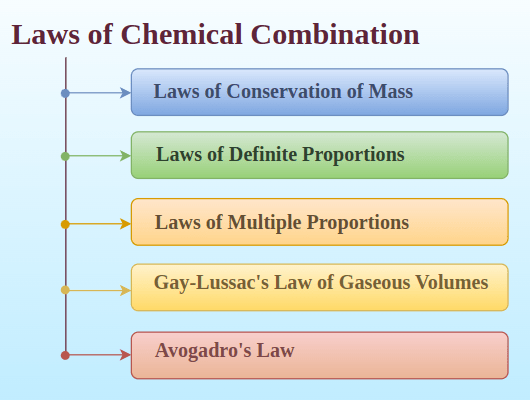What are the Laws of Chemical Combination
The laws of chemical combination played a significant role in the development of Dalton’s atomic theory of matter.
There are two important laws of chemical combination.

1. Law of conservation of mass
Law of conservation of mass was given by Lavoisier in 1774. According to the law of conservation of mass Matter is neither created nor destroyed in a chemical reaction. The substances which combine together in a chemical reaction are known as ‘reactants’ whereas the new substances formed as a result of chemical reaction are called ‘products’. The law of conservation of mass means that in a chemical reaction, the total mass of products is equal to the total mass of reactants. There is no change in mass during a chemical reaction.
Example: Lavoisier showed that when mercuric oxide was heated, it produced free mercury and oxygen. The sum of masses of mercury and oxygen was found to be equal to the mass of mercuric oxide
Mercuric oxide (100 g) → Mercury (92.6 g ) + Oxygen (7.4 g)
Solution:
Mass of the reactant = 100 g
Mass of the products = 92.6 + 7.4 g = 100.0 g
= 100 g
Since the total mass of the products formed is equal to the total mass of the reactants undergoing reaction, so the data is in agreement with low of conservation of mass.

2. Law of constant proportions
This law was discovered by the french chemists, A. Lavoisier and Joseph Proust. A pure chemical compound always contains same elements combined together in same proportion by mass
Example: Pure water obtained from different sources such as river, well, spring, sea, etc., always contains hydrogen and oxygen combined together in the ratio 1 : 8 by mass.
Limiting reagent: In a reaction having more than one reactant we must identify the limiting reagent “Reagent which is finished early is known as limiting reagent ”.
Example: In Haber’s process to manufacture NH3,
N2 + 3H2 → 2NH3
If we take 2 moles of N2 (56 grams) along with 3 moles of H2 (6 grams) we can see that only 1 moles of N2 (28 grams) is sufficient to react with 3 moles of H2. It means 1 mole N2 (28 grams) is in excess & H2 will be finished when reaction will be completed or H2 is limiting reagent.
